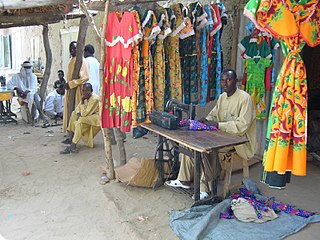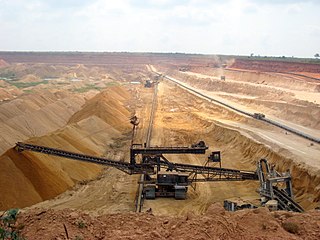 | |
| Currency | West African CFA franc (XOF, CFA) |
|---|---|
| 655.957 CFA francs per euro | |
| Calendar year | |
Trade organisations | AU, AfCFTA, WTO, ECOWAS, WAEMU |
Country group |
|
| Statistics | |
| Population | |
| GDP | |
| GDP rank | |
GDP growth |
|
GDP per capita | |
GDP per capita rank | |
GDP by sector |
|
| 2.0% (2020 est.) [6] | |
Population below poverty line | |
| 41.5 medium (2015) [9] | |
Labour force | |
Labour force by occupation | agriculture: 68% (2007 est.) [5] |
| Unemployment | 9.4% (2013 est.) [5] |
Main industries | foodstuffs, beverages; wood products, oil refining, gold mining, truck and bus assembly, textiles, fertilizer, building materials, electricity |
| External | |
| Exports | |
Export goods | cocoa beans, gold, rubber, refined petroleum, crude petroleum |
Main export partners |
|
| Imports | |
Import goods | crude petroleum, rice, frozen fish, refined petroleum, packaged medicines |
Main import partners | |
FDI stock | |
Gross external debt | |
| Public finances | |
| −4.2% (of GDP) (2017 est.) [5] | |
| Revenues | 7.749 billion (2017 est.) [5] |
| Expenses | 9.464 billion (2017 est.) [5] |
| Economic aid | recipient: ODA, $1 billion (1996 est.) |
The economy of Ivory Coast is stable and currently growing, in the aftermath of political instability in recent decades. The Ivory Coast's economy is largely market-based and depends heavily on the agricultural sector. Almost 70% of the Ivorian people are engaged in some form of agricultural activity. GDP per capita Archived 4 May 2012 at the Wayback Machine grew 82% in the 1960s, reaching a peak growth of 360% in the 1970s, but this proved unsustainable and it shrank by 28% in the 1980s and a further 22% in the 1990s. This decline, coupled with high population growth, resulted in a steady fall in living standards. The Gross national product per capita, now rising again, was about US$727 in 1996. It was substantially higher two decades before. Real GDP growth is expected to average 6.5% in 2024-25.
Contents
- History
- Infrastructure
- Agriculture
- Energy
- Mining
- Tourism
- External trade and investment
- Economic data
- Main indicators
- Other data
- See also
- References
- External links
After several years of lagging performance, the Ivorian economy began a comeback in 1994, due to the devaluation of the CFA franc and improved prices for cocoa and coffee, growth in non-traditional primary exports such as pineapples and rubber, limited trade and banking liberalization, offshore oil and gas discoveries, and generous external financing and debt rescheduling by multilateral lenders and France. [19] The 50% devaluation of franc zone currencies on 12 January 1994 caused a one-time jump in the inflation rate to 26% in 1994, but the rate fell sharply from 1996–1999. [19] Moreover, government adherence to donor-mandated reforms led to a jump in growth to 5% annually in 1996–99. [19] A majority of the population remains dependent on smallholder cash crop production. [20]





















